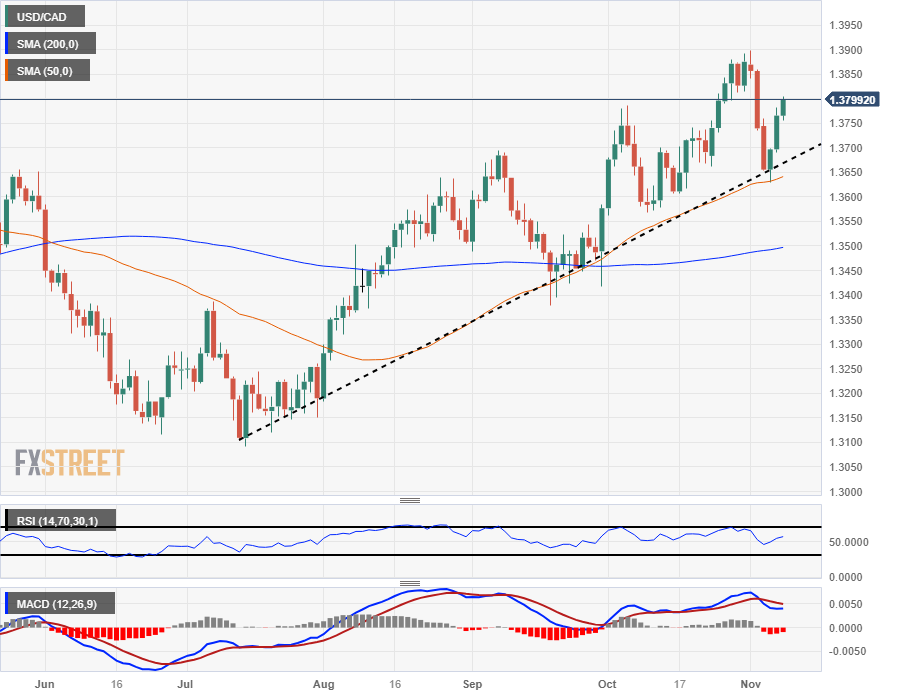- The Canadian Dollar continues to fall as the loonie loses support from oil.
- Canadian building permits also fell to five-month lows.
- The Canadian dollar falls 1% on the week.
He Canadian Dollar (CAD) is extending the week’s decline, being pushed lower as broader markets favor the US Dollar (USD) and crude oil supplies fall to four-month lows.
Last week’s rally to the close, fueled by investors announcing the end of the Federal Reserve’s (Fed) rate-hike cycle, is hitting a wall this week, and euphoria is being replaced by unease, as that fears of a global economic slowdown and ongoing geopolitical concerns weigh on risk appetite.
Daily summary of market movements: The Canadian dollar hits bottom again as investors expand their bets on the dollar
- The CAD is preparing for a third consecutive day of decline, retreating 1.25% from Monday’s highest bids.
- The recovery of the Dollar in the markets is causing a decline in the Canadian dollar after a brief recovery from 13-month lows.
- Canadian building permits fell 6.5% month-on-month in September, erasing August’s figure of 4.3% (revised up from 3.4%).
- Next week, data on housing starts in Canada will complete the picture of real estate development.
- Bank of Canada Deputy Governor Carolyn Rogers will speak on financial stability at an Advocis event in Vancouver on Thursday.
- The CAD is losing fundamental support as risk-off flows rebound against the Dollar and WTI (West Texas Intermediate) crude oil loses ground in barrel bids.
- WTI crude oil has fallen more than 9% from November highs.
Technical analysis
The USD/CAD pair returned to the 1.3800 zone during trading on Wednesday, as the zone retreated, extending the Dollar’s gains for the third consecutive day.
After seeing a technical bounce from the 50-day SMA near 1.3630 in confluence with a soft touch of the ascending trend line from July bid lows near 1.3100, USD/CAD is set for a new challenge of 13-month all-time highs in the 1.3900 area. Multi-year highs remain locked in after the October 2022 high at 1.3978.
Technical support for the long-term trend lies at the 200-day SMA, which currently rises to 1.2500, well below the price action, and indicator traders will note that the convergence-divergence oscillator of The moving average (MACD) continues to show sell warnings after confirming a moving average crossover signal last week.
USD/CAD Daily Chart

Price of the Canadian Dollar this week
Below is the percentage change of the Canadian Dollar (CAD) against the major currencies listed for this week. The Canadian dollar was the weakest currency against the Swiss franc.
| USD | EUR | GBP | CAD | AUD | JPY | NZD | CHF | |
| USD | 0.22% | 0.64% | 1.01% | 1.49% | 0.89% | 1.17% | -0.14% | |
| EUR | -0.21% | 0.42% | 0.80% | 1.26% | 0.69% | 0.95% | -0.35% | |
| GBP | -0.64% | -0.44% | 0.36% | 0.84% | 0.24% | 0.51% | -0.79% | |
| CAD | -1.02% | -0.80% | -0.37% | 0.47% | -0.13% | 0.15% | -1.17% | |
| AUD | -1.51% | -1.29% | -0.86% | -0.48% | -0.60% | -0.33% | -1.65% | |
| JPY | -0.90% | -0.68% | -0.48% | 0.14% | 0.60% | 0.27% | -1.04% | |
| NZD | -1.18% | -0.95% | -0.52% | -0.15% | 0.32% | -0.28% | -1.32% | |
| CHF | 0.14% | 0.35% | 0.77% | 1.14% | 1.62% | 1.02% | 1.29% |
The map shows the percentage changes of the major currencies against each other. The base currency is chosen in the left column, while the quote currency is chosen in the top row. For example, if you choose the euro in the left column and scroll down the horizontal line to the Japanese yen, the percentage change that appears in the box will represent EUR(base)/JPY(quote).
Frequently Asked Questions about the Canadian Dollar
What factors determine the price of the Canadian dollar?
The key factors that determine the price of the Canadian Dollar (CAD) are the level of interest rates set by the Bank of Canada (BoC), the price of oil, Canada’s largest export product, the health of its economy, inflation and the trade balance, which is the difference between the value of Canadian exports and its imports. Other factors are market sentiment, that is, whether investors are betting on riskier assets (risk appetite) or looking for safe havens (risk aversion), with risk appetite being positive for the CAD. As a major trading partner, the health of the US economy is also a key factor influencing the Canadian dollar.
How do the decisions of the Bank of Canada influence the Canadian dollar?
The Bank of Canada (BoC) significantly influences the Canadian dollar by setting the level of interest rates that banks can lend to each other. This influences the level of interest rates for everyone. The BOC’s main objective is to keep inflation between 1% and 3% by adjusting interest rates up or down. Relatively higher interest rates are usually positive for the CAD. The Bank of Canada can also use quantitative easing and tightening to influence credit conditions, with the first being negative for the CAD and the second being positive for the CAD.
How does the price of oil influence the Canadian dollar?
The price of oil is a key factor influencing the value of the Canadian Dollar. Oil is Canada’s largest export, so the price of oil tends to have an immediate impact on the value of the CAD. Generally, if the price of oil rises, the CAD also rises, as aggregate demand for the currency increases. The opposite occurs if the price of oil falls. Higher oil prices also tend to result in a higher probability of a positive Balance of Trade, which is also support for the CAD.
How does inflation data influence the value of the Canadian Dollar?
Although inflation has traditionally always been considered a negative factor for a currency, reducing the value of money, the opposite has actually happened in modern times, with the relaxation of cross-border capital controls. Inflation tends to lead central banks to raise interest rates, which attracts more capital from international investors looking for a lucrative place to store their money. This increases the demand for the local currency, which in the case of Canada is the Canadian dollar.
How does economic data influence the value of the Canadian dollar?
Macroeconomic data releases measure the health of the economy and can influence the Canadian dollar. Indicators such as GDP, manufacturing and services PMIs, employment and consumer sentiment surveys can influence the direction of the CAD. A strong economy is good for the Canadian dollar. Not only does it attract more foreign investment, but it may encourage the Bank of Canada to raise interest rates, resulting in a stronger currency. However, if economic data is weak, the CAD is likely to fall.
Source: Fx Street
I am Joshua Winder, a senior-level journalist and editor at World Stock Market. I specialize in covering news related to the stock market and economic trends. With more than 8 years of experience in this field, I have become an expert in financial reporting.







